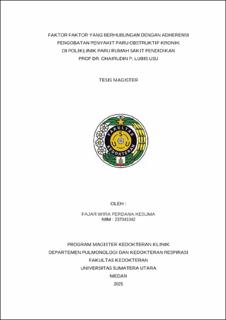| dc.description.abstract | Background: Chronic Obstructive Pulmonary Disease (COPD) is one of the leading causes of death and disability worldwide, with a persistently low level of treatment adherence. Adherence to therapy is crucial for controlling symptoms, reducing exacerbation rates, and improving the quality of life of COPD patients. Various factors are thought to influence adherence levels; however, data regarding these factors in Indonesia, especially in North Sumatra, remain limited.
Objective:This study aims to identify the factors associated with treatment adherence among COPD patients at the Pulmonary Clinic of Prof. Dr. Chairudin P. Lubis USU Teaching Hospital.
Methods: This research is an observational analytic study with a cross-sectional design. The sample consisted of 91 stable COPD patients treated at the Pulmonary Clinic of Prof. Dr. Chairudin P. Lubis USU Teaching Hospital from January to May 2025 who met the inclusion criteria. Data were collected using a structured questionnaire covering demographic, socioeconomic, and clinical characteristics, as well as adherence level assessed by the MMAS-8 instrument. Data analysis was performed bivariately using the chi-square test.
Results:The majority of respondents were over 50 years old (79.1%), male (76.9%), had a high school education or equivalent (49.5%), and high economic status (70.3%). Most lived near health facilities (75.8%) and received family support (80.2%). Good adherence was found in 80.2% of patients. There were significant associations between age, education level, economic status, distance to health facilities, degree of obstruction (GOLD), preferred inhaler device, knowledge level, satisfaction with health facilities, family support, and GOLD group with treatment adherence (p0.05).
Conclusion:Treatment adherence in COPD is influenced by age, education, economic status, distance to health facilities, degree of obstruction, preferred inhaler device, knowledge, satisfaction with health services, family support, and GOLD group. Efforts to improve adherence should focus on patient education, appropriate inhaler device selection, improved service access, and strengthened family support. | en_US |


